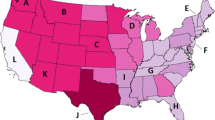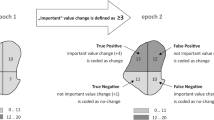Abstract
Because of the disability in visualizing statistical data with spatiotemporal information of choropleth map, we propose a novel method banded choropleth map (BCM). This technique makes use of space filling, splits sub-regions with equal width or area, and then fills partitions with different colors. It can utilize limited screen space more sufficiently than small multiples. It can also preserve context more clearly than animation. Based on the technique, we made a formal evaluation to find the efficiency of BCM in doing global task and local task under different factors.










Similar content being viewed by others
References
Zhang Y, Maciejewski R (2016) Quantifying the visual impact of classification boundaries in choropleth maps. IEEE Trans Vis Comput Graph 23(1):371–380
Friendly M, Denis DJ, Truman HS (2009) Milestones in the history of thematic cartography, statistical graphics and data visualization. Retrieved Feb 4, 2018 from http://www.math.yorku.ca/SCS/Gallery/milestone/milestone.pdf
Nusrat S, Kobourov S (2016) The state of the art in cartograms. Comput Graphics Forum 35:619–642
Boyandin I, Bertini E, Lalanne D (2012) A qualitative study on the exploration of temporal changes in flow maps with animation and small-multiples. Eurographics Conference on Visualization (EuroVis) 31:1005–1014
Griffin AL, Maceachren AM, Hardisty F, Steiner E, Li B (2006) A comparison of animated maps with static small-multiple maps for visually identifying space-time clusters. Ann Assoc Am Geogr 96(4):740–753
Sun G, Liang R, Qu H, Wu Y (2017) Embedding spatio-temporal information into maps by route-zooming. IEEE Trans Vis Comput Graph 23(5):1506–1519. Ronald E. Anderson Social impacts of computing: Codes of professional ethics. Soc Sci Comput Rev 10, 2: 453–469
Andrienko N, Andrienko G (2004) Interactive visual tools to explore spatio-temporal variation. In: Advanced Visual Interfaces, pp 417–420
Andrienko G, Andrienko N, Bremm S, Schreck T, Landesberger TV, Bak P, Keim D (2010) Space-in-time and time-in-space self-organizing maps for exploring spatiotemporal patterns. Comput Graphics Forum 29(3):913–922
Fuchs G, Schumann H (2004) Visualizing abstract data on maps. In: Eighth international conference on information visualisation, pp 139–144
Wishart J (1963) Statistical tables for biological, agricultural and medical research. Oliver and Boyd 40(1):104–114
Funding
This research was supported by the Natural Science Foundation of China under Grant No. 61402435 and the National Key Research and Development Plan under Grant Nos. 2016YFB1000600 and 2016YFB0501900.
Author information
Authors and Affiliations
Corresponding author
Rights and permissions
About this article
Cite this article
Du, Y., Ren, L., Zhou, Y. et al. Banded choropleth map. Pers Ubiquit Comput 22, 503–510 (2018). https://doi.org/10.1007/s00779-018-1120-y
Received:
Accepted:
Published:
Issue Date:
DOI: https://doi.org/10.1007/s00779-018-1120-y




